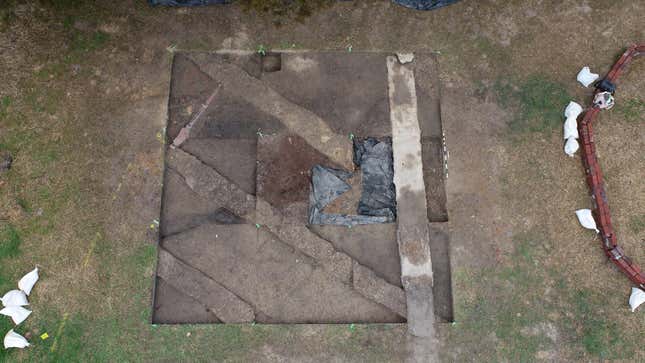
Despite the amount of history that sits atop its soil, plenty of stories remain buried below Colonial Williamsburg. One of those stories is that of the First Baptist Church of Williamsburg, an early Black church that stood until the 1950s on the historic site, on which excavations began last fall. Now, archaeologists have found human remains on the site; further assurance that the team was digging in the right place, and a step towards being able to connect those interred residents of the past with today’s descendant community.
Announced in a community meeting this week, the found remains include a human tooth and probable finger bone, alongside a trove of other fragmentary bones that are harder to attribute to any one species. Animal bones were also found on the site, which is currently an approximately 400-square-foot (37-square-meter) area on the west side of Colonial Williamsburg, at the intersection of Francis and Nassau Streets.
“We see on the wear of this tooth that it was incredibly worn, indicating the individual was likely pretty old,” Jack Gary, the archaeological director at Colonial Williamsburg, said in a phone call. “Going beyond that is pretty difficult, but what it’s indicating to us is that there likely are more burials there. We identified one grave shaft, and we’re expanding off of that to find evidence of more.”
In October 2020, the excavations turned up artifacts indicative of a church that operated from the early 19th century through the 1950s, first in a meeting house and, by 1856, in a brick-and-mortar building. Those finds included ceramic, nails, glass, a posthole, and an ink bottle. In the 1950s, the century-old building was torn down, and a parking lot was put at the intersection, near the College of William and Mary. The site was largely bypassed for study at the time; just before the parking lot was constructed, a team of Black workers excavated parts of the site in diagonal trenches, turning up little but the soil itself. In the decades since (at least until recently), the history of the site has also received little scrutiny. Even the relatively recent history of the Black excavators points to that, with all but one of whom remain unidentified.
The ongoing church excavations are coming at the same time as other revelations about Black history in Williamsburg; today, researchers announced that a small, white building on the nearby William and Mary campus was the site of the Williamsburg Bray School, a mid-18th-century structure which focused on the education of free and enslaved Black children. Plans are being drawn up to relocate the historic building to the Historic Area of Colonial Williamsburg.
The First Baptist Church was founded by Gowan Pamphlet, a tavern worker who preached to fellow Black Christians. The congregation included both free, educated Black residents of Williamsburg and enslaved believers, as Pamphlet was. Large gatherings of Black people were forbidden out of fears of slave uprisings, so Pamphlet’s congregation at first worshipped in secrecy. Pamphlet became the first ordained Black preacher in the country in 1772, and nearly 20 years later was granted his freedom. By the early 19th century, the congregation was permitted use of a building at the intersections of Francis and Nassau Streets. By 1818 Pamphlet had died, but a Baptist Meeting House had been built on the site; a permanent home for the once-itinerant worshippers. Just before the Civil War, that meeting house was replaced with a brick church—the subject of the ongoing excavations.

The bulk of the ongoing archaeological work is focused on carefully sifting through those already-disturbed layers, in order to reach the undisturbed graves further down. The initial phase of excavations turned up the foundations of the 1856 church, and an earlier, yet-unidentified building. While the discovery of human remains on the site is unsurprising (it was once a church, after all), it adds gravity to the work being done. Members of the descendant community once worshipped in the church destroyed in the 1950s. It is a lived history, and one that the archaeological team is working closely with the community on to treat the work with all due sensitivity.
“I think the thing that’s most gratifying for me and what’s keeping the buzz going in the church is that [the descendent community] never thought anyone would bust up that parking lot and explore remnants of their history,” said Connie Matthews Harshaw, president of the Let Freedom Ring Foundation, a cultural heritage and preservation organization for the First Baptist Church, in a phone call. “They had pretty much given up, and people in church were saying ‘I didn’t think in my lifetime it would be done.’”

Harshaw added that the story of the site is finally being told in a way that includes the voices of the church community that once used the site, rather than the narratives that propagated during the Jim Crow era. Gary, the archaeologist, said that the months ahead would focus on further clearing the already-disturbed topsoil, and getting a better sense of the number of graves on the site and their layout.
Once that’s done, genetic testing will begin on the site’s remains, in a collaboration with the Institute for Historical Biology at William and Mary. Though the precise identification of individuals is unlikely, the tests (if successful) would be able to forge lineages between the interred individuals and the current worshippers, whose parents, grandparents, and great-grandparents had lived in the area and attended the church in its original location.
“The descendant community is excited by the possibility, and they all want the insides of their mouths swabbed so if there’s an opportunity to make familial ties to the remains that are there,” Harshaw said. “They want to do it. We can’t get there fast enough.”